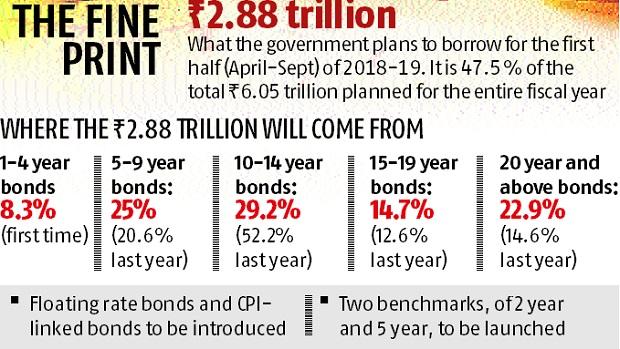Why in news?
Union government plans to borrow Rs 2.88 trillion in FY 2018-19.
What is union government’s plan on borrowing?
- Union government has planned to borrow Rs 2.88, against market expectation of Rs 3.3-3.6 trillion.
- To meet its fiscal demands government usually borrows from the bond market and by using other instruments.
- The normal practice of borrowing from the bond market will be around 60-65 per cent.
- For now first half of borrowing government has planned 47.5% of budgeted amount for 2018-19.
- The weekly borrowing size would also be Rs 120 billion, against the usual Rs 150-180 billion.
- The Union will also reduce its planned buyback of government securities (G-Secs) by Rs 250 billion.
How this borrowing has been planned?
- The government plans to draw an additional Rs 250 billion from the National Small Savings Fund (NSSF) to finance the fiscal deficit for 2018-19.
- For this RBI, on behalf of the government, will be issuing bonds in 1-4 year maturity, raising Rs 240 billion through the papers.
- Inflation-indexed bonds linked to the consumer price index (CPI), and floating rate bonds will be used to raise 10 per cent of the first-half borrowing.

- The borrowing will also be done through instruments that have been in demand in the market, instead of a maturity profile in the shape of 10-14 years.
- The government also said it would introduce new benchmarks in the 2-year and 5-year categories.
What are the benefits of this move?
- Government’s move had been welcomed by bond market player as it will ease pressure on the market considerably by reducing the first-half borrowing.
- The borrowing plan will allow the government to meet all its expenditure requirements without getting into an overdraft situation.
- CPI-linked bonds will have much better chance of success compared to WPI linkers.
- The borrowing profile will help banks and other investors invest in bonds again.
- This will also ease the redemption pressure on the government at the cost of duration risk on the bank credits.
- Introduction of benchmarks allows government to raise money through bonds and liquidity and allows to create many other derivatives.
Source: Business Standard
